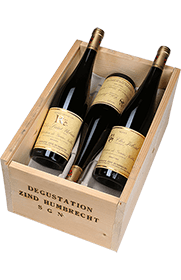The history of the estate
Located in Turckheim in Haut-Rhin in Alsace, the Domaine Zind-Humbrecht, in the Herrenweg vineyard, is known throughout the world as one of the three « Alsace greats. » The Humbrecht family has been making wine since 1620, but in 1959, following the marriage of Léonard Humbrecht and Geneviève Zind, the estate change dits name and became Zind-Humbrecht. Since 2009, the estate has been run by their son, Olivier, who was made the first French « master of wine » and is considered one of the best winemakers in the world. A pioneer in producing concentrated Alsace wines with a fruity character through low yields, the estate has long operated along biodynamic guidelines and was granted a certificate in 2002.
The many terroirs of the Domaine Zind-Humbrecht
The estate’s 40 hectares of wine are planted on 10 different terroirs in six communes : Herrenweg (11.5 ha), the Clos Windsbuhl (5.15 ha) at Hunawihr, the grand cru of Rangen at Thann (5.5 ha), Rotenberg (1.8 ha) and the Clos Häuserer (1,2 ha) at Wintzenheim, Hengst at Wintzenheim (1.4 ha), Brand at Turckheim (2.4 ha), the Clos Jebsal (1.3 ha) and Heimbourg (4 ha) at Turckheim and Goldert at Gueberschwihr (0,9 ha). The typical alsace grapes flourish on soils with distinct characteristics which bring out the best in them. Most of the plots are planted in grand cru areas.
Vine growing
The vines are cultivated manually by growers with the help of animal traction, to preserve plant growth and soils as much as possible. The harvests are done only when the grapes are completely ripe so as not to make any changes in the wine that could divert and alter the sensory rewards brought by the terroir.
Winemaking at the estate
The Zind-Humbrecht estate practises slow winemaking to let the fermentation happen in its own time and not to rush the wine. Ageing on lees takes 6 months and the wine is bottled one or two years after the harvest, allowing it to be ready for customers to taste it. The vine yields are low – 35 hectolitres per hectare on average, allowing the wine to develop with scents and an intense structure. Classic Zind-Humbrecht wines are sweet wines from late harvests and noble rotted sweet wines.













